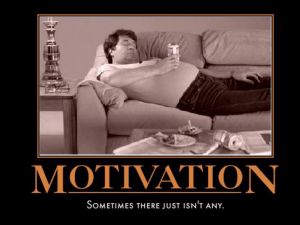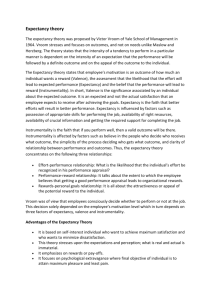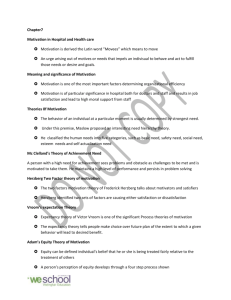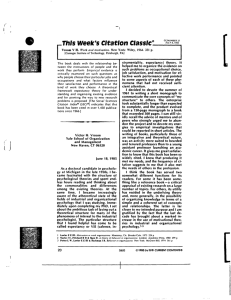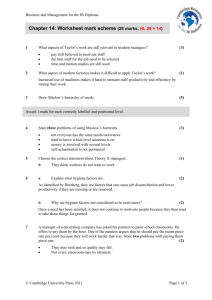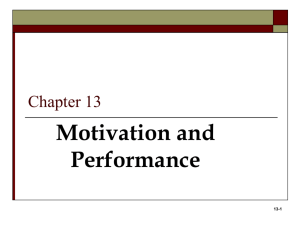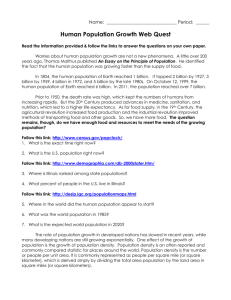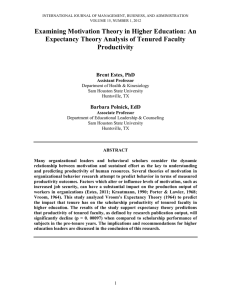MOTIVATION THEORY (HL)
advertisement
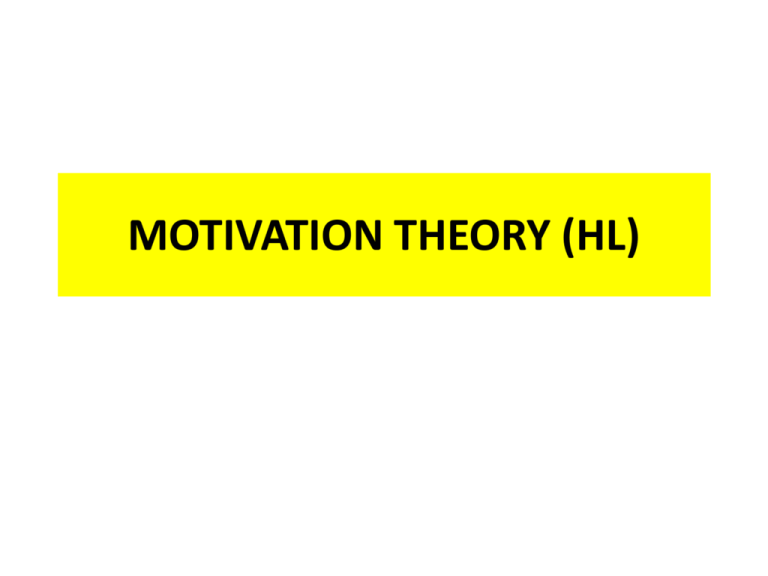
MOTIVATION THEORY (HL) ELTON MAYO • Mayo is most famously known for describing the “Hawthorne Effect” (1933) which occurs when the output of a worker or team improves because the people are being observed or appreciated at work. Work Place Experiment Mayo • The most commonly cited example is when managers changed the lighting conditions at work in one factory. • When they increased the lighting at the factory productivity improved. • When the lights were dimmed productivity also improved. • Mayo concluded that people derive a great deal of satisfaction at work from social interaction in the workplace. • Just the fact that the managers were taking an interest in work conditions made employees feel important and established their cooperation. • As a result, output increased. Money & Physical Conditions at Work Little Value: Mayo & Herzberg. • In a similar way to Herzberg, Mayo believed that money and physical conditions at work had little motivational value. • Mayo believed that the value of social interaction at work and the content of work were far more important when it came to intrinsic motivation. DAVID McCLELLAND • McClelland proposed that a worker’s needs are acquired over time and are formed by life experiences. • McClelland classified these need as achievement, affiliation and power, and argued that a worker’s motivation are affected by these needs. DAVID McCLELLAND Achievement • People with high achievement needs like to succeed and will thus avoid easy tasks (because these tasks will not challenge them). • They will also avoid high risk challenges because the chances of success are low (and they do not like to fail) • Achievers like regular feedback so that they know that they are achieving. • They also like to work on their own or with other achievers so they can contribute to their success. DAVID McCLELLAND Affiliation • People with affiliation needs like to work in a harmonious work environment where they are liked and accepted. • They like to work in an environment with considerable social interaction and they will go out of their way to contribute to make people feel needed. • These individuals enjoy being team members and tend to perform well in roles where there is considerable social interaction. DAVID McCLELLAND Power • McClelland’s final motivator is the need for power. • Some people like to have power over an individual, while others may want to have power over a group. • These individuals strive to direct the actions of others to further goals of the organization. PROCESS THEORIES OF MOTIVATION • Process theory refers to the process that originally initiated a behaviour. • Eg: If a teacher praises a student for a good piece of work then that outcome (a good piece of work) will be repeated if the same process (praise) is repeated. • Equity theory and expectancy theory come under the category of the process theories of motivation. VICTOR VROOM & EXPECTANCY THEORY • Vroom argues that individuals strive to maximize pleasure and minimize pain. • The most important features of the theory (1964) are expectancy, instrumentality and valence. VICTOR VROOM & EXPECTANCY THEORY Expectancy • This refers to whether or not people expect that they will be able to achieve a given role or task. • If people expect they can do a given job they will be motivated to do it. • Highly confident individuals who have the support of their superiors and colleagues and the necessary tools for the job, are likely to have a high perception of their expectancy. VICTOR VROOM & EXPECTANCY THEORY Instrumentality • This refers to the likelihood that workers will be rewarded in some way if they do a good job. • If individuals see some kind of “carrot” for doing a good job, then it is more likely they will perform well. • So if you believe that there is a good chance that your parents will reward you if you get good grades, then you will view your work as having a high instrumentality. • Work paid largely on a commission basis is designed to make workers believe that there is a high probability that if they perform well they will be rewarded. VICTOR VROOM & EXPECTANCY THEORY Valence • This describes the emotional connection people attach to a given outcome. • If you like receiving praise then that outcome is positively valent. • If you feel a job will cause too much stress or tiredness then you will avoid it. • Those outcomes have negative valence. • An employer could use positive valence to motivate employees and make sure that employees know what rewards they are likely to receive for good performance. VICTOR VROOM & EXPECTANCY THEORY • Vroom believes that an employee will have high motivation if the employee expects to be able to do the job (expectancy), believes the job will have a positive reward (instrumentality) and has a positive emotional connection with the work (positive valence). JOHN STACY ADAMS & EQUITY THEORY • The second process theory of motivation is Adam’s equity theory. • Adam argues that people who believe that they are rewarded too much or too little for their job will experience “pain” or dissatisfaction at work. • They will therefore seek to redress the perceived imbalance. JOHN STACY ADAMS & EQUITY THEORY • Workers do not have to all receive the same – they just have to perceive that what they get from the organization is consistent with the contribution they make to it. • Of course, different people will have different views on this. • If employees believe that they are underrewarded at work for their contribution, they will be motivated to redress that imbalance.

